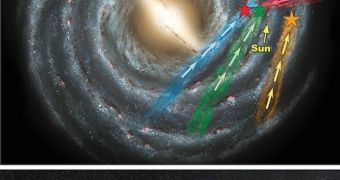A team of astronomers was recently able to discover a new class of hypervelocity stars that appear to be heading towards the outskirts of the Milky Way, and then further out into intergalactic space.
What makes these objects different from other hypervelocity stars is the fact that they were not thrown out of the galaxy by Sagittarius A*, the supermassive black hole powering up its core.
Hypervelocity stars got their name from the fact that they are moving incredibly fast, even by stellar standards. Regular objects in this category are massive, young blue stars, which develop at the cores of galaxies before interactions with the black holes inhabiting these regions cast them on their merry way.
What researchers from the Vanderbilt University have discovered in the new study is a group of 20 hypervelocity stars that display none of these characteristics.
They are middle-aged stars, having been born around the same time as the Sun (around 4.6 billion years ago). They are also considerably smaller than such objects usually are.
Vanderbilt astronomer Lauren Palladino, the lead author of the new study, said in a recent statement that the newly-discovered stellar population apparently did not interact with Sagittarius A* before they set out to leave they galaxy. “These new hypervelocity stars are very different from the ones that have been discovered previously,” she said.
“The original hypervelocity stars are large, blue stars, and appear to have originated from the galactic center. Our new stars are relatively small – about the size of the Sun – and the surprising part is that none of them appear to have come from the galactic core,” the expert went on to say.
For this research, Vanderbilt investigators used data from the Sloan Digital Sky Survey (SDSS) to map the paths of numerous stars traveling through our galaxy. Currently, average stars move through the Milky Way at a speed of 970,000 kilometers (600,000 miles) per hour, but hypervelocity stars have to travel at 1.6 million kilometers (1 million miles) per hour to escape the galaxy's gravitational pull.
The new discovery, detailed earlier this month at the 223rd meeting of the American Astronomical Society, in Washington DC, indicates that astronomers do know not even half of what they thought they knew about hypervelocity stars, Space reports.
“None of these hypervelocity stars come from the center, which implies there is an unexpected new class of hypervelocity star – one with a different ejection mechanism,” concluded Vanderbilt astronomer and study collaborator Kelly Holley-Bockelman.

 14 DAY TRIAL //
14 DAY TRIAL //